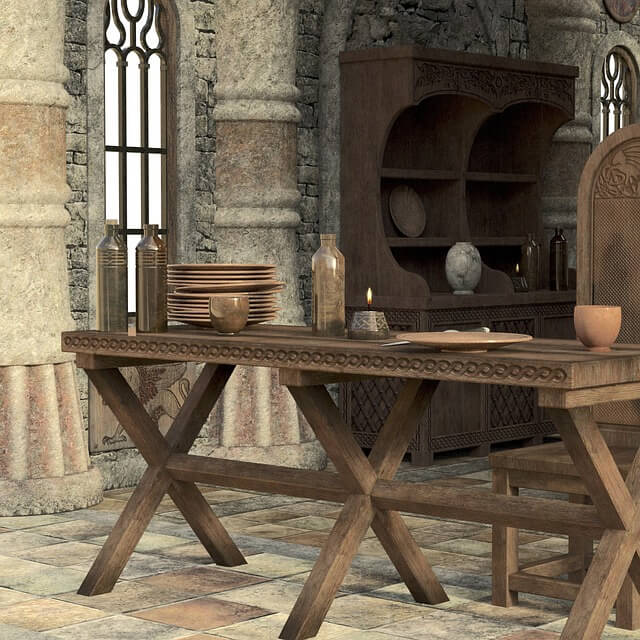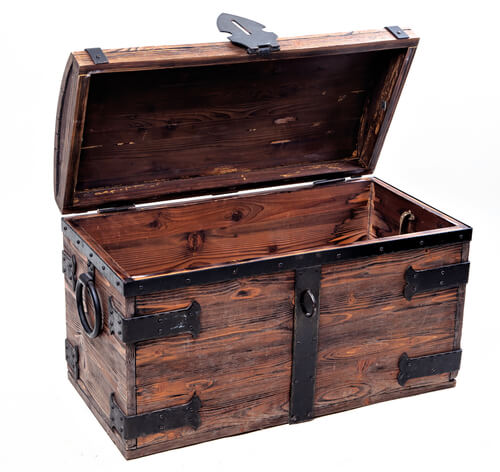Medieval Decor

Medieval decor can be a dream come true for lovers of history, art, legends or even fantasy. The medieval decor style perfectly balances the austerity of stone with elements such as lavishly detailed wood, wrought iron, and textiles.
The Middle Ages began in the 5th century and extended until the 15th century. There were many art styles during the span of the Middle Ages and they took on all kinds of forms: architecture, sculpture, goldwork, manuscripts, frescos, board paintings, mosaics, tapestries, etc.
As a result, creating a medieval decor style gives you the freedom to draw inspiration from many different elements. For example, some people choose to decorate with sets of medieval objects (armor, tapestries, shields, swords, etc.) while others look to certain combinations of textures and colors. The perfect decor all boils down to personal preferences.
Creating medieval decor can be easy as long as you have a clear idea of what you want as well as a plan that works with your budget. In any case, checking out a documentary on medieval times or doing some research beforehand is always a good idea.

The basic building blocks of medieval decor
First and foremost, this decor style needs two materials to come to life: stone and wood. Not everyone will have stone walls or wooden cabins, but today, we can mimic the materials with textured wallpaper or other options.
You can create a living room where stone and wrought-iron set the tone, or try a room where wood and fabrics take center stage.
Remember that in order to create a medieval look, you have to be careful to not overwhelm your walls with decor accessories. Instead, try some nice curtains and a banner or figurehead.
Let’s take a look at the types of furniture– and their placement– that can help create the right setting.
Furniture for a medieval setting
Medieval furniture tends to be solid, large pieces so it’s important to ensure that you have the space for them in your home. Try looking for versions that have sizes for modern-day homes.
- Tables: aim for completely wooden tables that have a rustic feel to them.
- Chairs: wide wooden chairs can elude to thrones and work great in living rooms. In your dining room, try straight wooden chairs with or without carved details.
- Chests and trunks: chests are great for adding a magical or antique touch. Make sure to pick the right material (wood, leather, synthetic materials, metal). They look great alongside a rug or a natural fiber throw.
- Standing shelves: use shelves to showcase objects that evoke this time period: sculptures, books, mini-sets of armor, etc.
- Light fixtures: if possible, choose simple options that aren’t too bright. Remember, in medieval times, the light came from candles and torches.

For medieval-lovers, we recommend looking for the right furniture pieces in an antique store or special furniture store. You can also custom-order pieces from a reputable furniture-maker.
Types of lighting
As for the lighting, common spaces (like the dining room and living room) should use gentle, warm lights just as we mentioned earlier. With gentle lighting, you can create the feeling of a torch-lit space.
But your decor will also need natural lighting. So if you have big windows, make sure to make the most of them.
Medieval accessories
While you don’t have to use a rug, they can create a wonderful setting. The trick is to look for a rug that harmonizes with its surrounding area by having the right material and colors. Cowhide rugs are a great option.
Or, if you have wooden or stone floors, you’re better off leaving them uncovered. Instead, focus your attention on other areas that could use medieval decor.
As for other decorative accessories, you’ll definitely need sets of armor, swords, and shields. They’ll help create a little magic. If you have a family crest to show off, even better.

Other considerations
A medieval color palette should include reds and golds. In addition, greens, blues and the shades in between can also make the right setting.
On a different note, make sure that your textiles balance steadily between ornate decor and austerity. In other words, you shouldn’t rely solely on detailed accessories nor a single color. A little variety can help enrich spaces.
Creating a medieval decor can take you back in time and set your imagination free.
Medieval decor can be a dream come true for lovers of history, art, legends or even fantasy. The medieval decor style perfectly balances the austerity of stone with elements such as lavishly detailed wood, wrought iron, and textiles.
The Middle Ages began in the 5th century and extended until the 15th century. There were many art styles during the span of the Middle Ages and they took on all kinds of forms: architecture, sculpture, goldwork, manuscripts, frescos, board paintings, mosaics, tapestries, etc.
As a result, creating a medieval decor style gives you the freedom to draw inspiration from many different elements. For example, some people choose to decorate with sets of medieval objects (armor, tapestries, shields, swords, etc.) while others look to certain combinations of textures and colors. The perfect decor all boils down to personal preferences.
Creating medieval decor can be easy as long as you have a clear idea of what you want as well as a plan that works with your budget. In any case, checking out a documentary on medieval times or doing some research beforehand is always a good idea.

The basic building blocks of medieval decor
First and foremost, this decor style needs two materials to come to life: stone and wood. Not everyone will have stone walls or wooden cabins, but today, we can mimic the materials with textured wallpaper or other options.
You can create a living room where stone and wrought-iron set the tone, or try a room where wood and fabrics take center stage.
Remember that in order to create a medieval look, you have to be careful to not overwhelm your walls with decor accessories. Instead, try some nice curtains and a banner or figurehead.
Let’s take a look at the types of furniture– and their placement– that can help create the right setting.
Furniture for a medieval setting
Medieval furniture tends to be solid, large pieces so it’s important to ensure that you have the space for them in your home. Try looking for versions that have sizes for modern-day homes.
- Tables: aim for completely wooden tables that have a rustic feel to them.
- Chairs: wide wooden chairs can elude to thrones and work great in living rooms. In your dining room, try straight wooden chairs with or without carved details.
- Chests and trunks: chests are great for adding a magical or antique touch. Make sure to pick the right material (wood, leather, synthetic materials, metal). They look great alongside a rug or a natural fiber throw.
- Standing shelves: use shelves to showcase objects that evoke this time period: sculptures, books, mini-sets of armor, etc.
- Light fixtures: if possible, choose simple options that aren’t too bright. Remember, in medieval times, the light came from candles and torches.

For medieval-lovers, we recommend looking for the right furniture pieces in an antique store or special furniture store. You can also custom-order pieces from a reputable furniture-maker.
Types of lighting
As for the lighting, common spaces (like the dining room and living room) should use gentle, warm lights just as we mentioned earlier. With gentle lighting, you can create the feeling of a torch-lit space.
But your decor will also need natural lighting. So if you have big windows, make sure to make the most of them.
Medieval accessories
While you don’t have to use a rug, they can create a wonderful setting. The trick is to look for a rug that harmonizes with its surrounding area by having the right material and colors. Cowhide rugs are a great option.
Or, if you have wooden or stone floors, you’re better off leaving them uncovered. Instead, focus your attention on other areas that could use medieval decor.
As for other decorative accessories, you’ll definitely need sets of armor, swords, and shields. They’ll help create a little magic. If you have a family crest to show off, even better.

Other considerations
A medieval color palette should include reds and golds. In addition, greens, blues and the shades in between can also make the right setting.
On a different note, make sure that your textiles balance steadily between ornate decor and austerity. In other words, you shouldn’t rely solely on detailed accessories nor a single color. A little variety can help enrich spaces.
Creating a medieval decor can take you back in time and set your imagination free.
All cited sources were thoroughly reviewed by our team to ensure their quality, reliability, currency, and validity. The bibliography of this article was considered reliable and of academic or scientific accuracy.
Cherry, John: Las artes decorativas medievales, Madrid, Akal, 1999.







